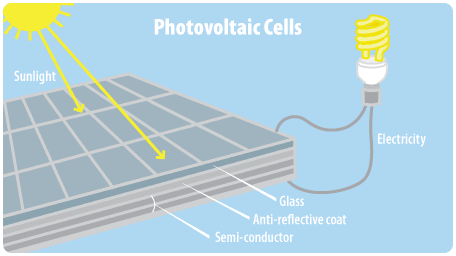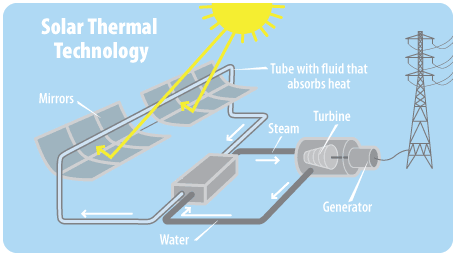MCE’s Energy 101 Series focuses on the why and how of renewable energy so that you can learn more about concepts like the benefits of biomass and the science behind solar. Looking for more? Check out the links in this blog to read more about Energy 101 or to dive deeper into our Energy Expert series.
Did you know the sun is the biggest source of energy for the earth? In fact, the amount of solar radiation that hits the earth for just one hour is enough energy to meet global electricity needs for up to a year. In this blog, we break down how solar energy is captured and turned into electricity.
How Do Solar Systems Work?
There are two primary types of solar energy systems: photovoltaic and solar thermal. Photovoltaic panels are commonly seen on rooftops and convert sunlight directly into electricity. Solar thermal systems use the sun to create heat; the heat powers a turbine; and the turbine generates electricity like a traditional steam engine.
Photovoltaic solar systems generate electricity on a utility scale and in individual homes and businesses.
- Sunlight hits the photovoltaic cells, which have positively and negatively charged layers that form an electric field.
- Photons from the sunlight knock electrons loose. These electrons flow through the electric field to generate an electric current.
- The electric current flows to an inverter that converts it into electricity.
- This converted electricity flows onto the grid.

(Graphic: EPA)
Solar thermal systems generate electricity on a utility scale.
- Mirrors reflect and magnify the sun’s rays to heat a liquid.
- When the liquid boils, it creates steam.
- The steam flows through a turbine and causes the blades to rotate.
- The rotating blades create mechanical energy. A generator picks up this energy and converts it into electricity.

(Graphic: EPA)
What Is Net Energy Metering (NEM)?
Many residents and businesses install solar to reduce their electricity bills and carbon footprint. Net energy metering (NEM) uses special energy meters to track of the difference between how much electricity a solar customer’s system generates and how much they use. These customers are then provided a credit toward their utility bill for any excess electricity that they put back on the grid. The amount of energy that solar panels generate varies. During summer months when the sun is shining brightly, panels generate more energy, adding to solar customers’ generation credit balance. In winter months, those with solar panels are more likely to pull electricity from the grid and use the credit balance that they have accumulated to offset their bill.
Learn more about how MCE’s Net Energy Metering (NEM) Program works or stay tuned for our Energy Expert blog on NEM.
What Is Solar-Plus-Storage?
Solar-plus-storage is the pairing of a solar system with a battery system. This pairing allows solar energy to be stored during the day when it’s abundant, so that it can be used at night or during time-of-use peak hours when electricity rates are higher. Pairing solar with storage helps reduce our reliance on fossil fuels. It also creates a more balanced energy grid, where the energy supply more closely matches the energy demand at any given time.
In addition to balancing the electric grid, solar-plus-storage promotes energy resiliency. Solar-plus-storage systems can ensure that households and businesses have access to clean, fossil-free backup power during power outages.






